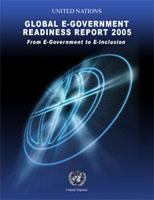
From E-Government to E-Inclusion
The spread of information technologies to a select group of people in the world is worsening disparities between the e-haves and the e-have-nots. There is a danger that unequal diffusion of technology, far from fomenting cohesion by providing opportunity, will result in reinforcing the traditional patterns of economic and social inequalities which will lead to a weakening of social bonds and cultural organization.
Exploring the interlinkages between e-government and human development, Part II of the UN Global E-Government Development Report 2005 points to the need to place development thinking within what it terms as the Socially Inclusive Governance Framework which is a multi pronged approach to promoting ICT-led real access, with a special focus on the need to promote access and inclusion to the disadvantaged groups in society. The Socially Inclusive Governance for Information Society Framework is a 'vision' for restructured thinking about developing an inclusive information society based on the appreciation of the capabilities of each and every person; the dignity that economic and social choice brings; and the freedom to partake it all. Since information technologies facilitate the dissemination of information and the opportunity of feedback, they form the perfect conduit for citizen-government partnership to promote public value. Inclusion and participation through ICTs, e-inclusion is the key tool at the disposal of a socially inclusive government. E-inclusion goes beyond e-government. It means employing modern ICT technologies to address the issues of access-divide and promote opportunities for economic and social empowerment of all citizens.
Building upon this framework, the analysis in Part II of the Report illustrates that the majority of the developing country population faces a grave challenge from the new technological revolution. Whereas some of the developing countries which have in place the right mix of reforms, institutions and programs will no doubt benefit from the ICTs, most are likely to be mired in a cycle of low income, poverty and a growing disparity in access to modern technology.
 Bienvenidos a las Naciones Unidas
Bienvenidos a las Naciones Unidas